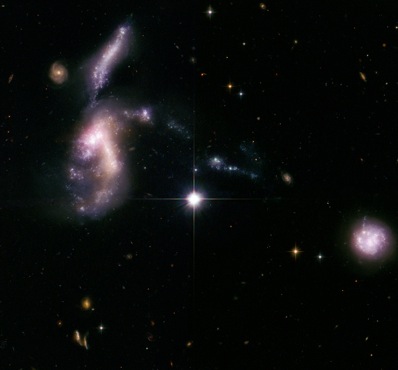



|

|

Young-looking galaxies
race to oblivion
KEITH COOPER
ASTRONOMY NOW
Posted: 19 February 2010


Four galaxies on a crash course with each other have been imaged by the Hubble Space Telescope, revealing that these dwarf spirals are curiously fresh-faced and seem to have been in stasis for ten billion years.
The four galaxies – two of which are already merging, another that is face-on and one that is seen edge-on – form the Hickson Compact Group 31, which is 166 million light years away. Each galaxy is about 20,000 light years across, and are all within 75,000 light years of each other. That might sound like a large distance, but they could all easily fit inside our Milky Way Galaxy.
 Hickson 31, with the two galaxies already colliding on the left, another edge-on galaxy immediately above them, and a fourth face-on spiral at the lower right. The bright object in the centre of the picture is a foreground star, whilst a background spiral galaxy can also be seen on the left edge of the picture. Image: NASA/ESA/J English (University of Manitoba)/Hubble Heritage Team (STScI/AURA). Hickson 31, with the two galaxies already colliding on the left, another edge-on galaxy immediately above them, and a fourth face-on spiral at the lower right. The bright object in the centre of the picture is a foreground star, whilst a background spiral galaxy can also be seen on the left edge of the picture. Image: NASA/ESA/J English (University of Manitoba)/Hubble Heritage Team (STScI/AURA).
Though diminutive in size, together the four galaxies contain five times more hydrogen gas than our Galaxy. This is primordial gas, untouched since these dwarf galaxies were born, and the gravitational tides as the galaxies begin to near each other are stirring up this gas, creating enormous starbursts that are manifest in the shape of giant clusters of about 100,000 stars each.
“Hubble has the sharpness to resolve the individual clusters, which allows us to age-date them,” says Dr Sarah Gallagher of The University of Western Ontario, Canada, who led the Hubble observations. With added data in the infrared from the Spitzer Space Telescope, and in the ultraviolet from NASA’s Swift and Galaxy Evolution Explorer (GALEX) satellites, Gallagher has been able to determine that the star clusters are less than ten million years old and are filled with hot, blue, massive stars. The galaxies of Hickson 31 look in all the world like young, newly formed galaxies, but Hubble also revealed a smattering of globular clusters about ten billion years old, showing that the galaxies themselves are actually quite ancient. So what have these galaxies been up to for the last ten billion years?
The answer is, not very much. According to Gallagher, these galaxies may have resided in a quiet, low density region of the Universe, and that this is the first time in their long history that they have wandered into the vicinity of other galaxies. Drifting towards one another at relative velocities of about 60 kilometres per second, in a billion years they should have completely merged into a single, modest elliptical galaxy, in the process using up all that gas in an enormous, final burst of star formation. It seems all the fun for these galaxies is coming right at the end of their lives.
|

|

|

|
|



